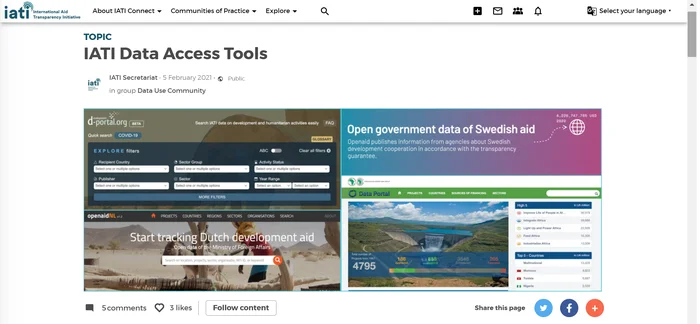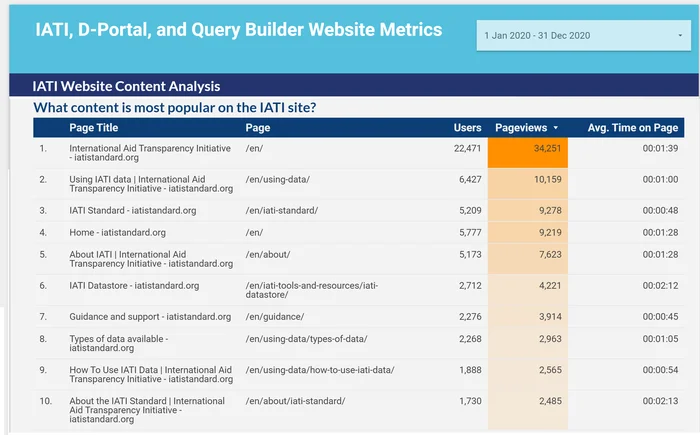Understanding access and use of IATI data
A new report, funded by IATI’s Data Use Working Group, has researched how IATI data is being accessed and used. Open Data Watch, who delivered the report, were tasked with creating an inventory of IATI training materials and data use tools and conducting a gap analysis to understand what materials could be created to support data users.
Inventory of IATI training materials and data use tools
Open Data Watch gathered IATI training materials and data use tools available online provided both by IATI and external organisations. They defined training materials as videos, guides, courses, or other training programs on how to use IATI data or tools for using IATI data. Data use tools included portals, apps, or websites that use IATI data to provide a service or provide access to IATI data.
Their research found 15 IATI training materials and 27 IATI data use tools. Most examples of training materials included in the inventory were user guides, but also included a video, webinar and online training course. Using the inventory of data use tools as a starting point, a list of data access tools has been published to provide users with information on the range of ways they can access IATI data.
View Data Access Tools

Find an up-to-date list of IATI data access tools on IATI Connect.
Significant user-demand for IATI data and training materials
By using a series of web analytics, Open Data Watch established that there is a high demand for IATI data. They produced a public dashboard showing that in 2020 IATI’s search platform d-portal attracted 337,730 views from 43,419 users (up 68% from previous year).
Their research also confirmed that IATI stakeholders have a significant demand for training materials:
- After the home page, the most popular page on IATI’s website provides guidance on how to use IATI data
- Many other of the most popular pages are related to training: #5 About IATI, and 7, 8, 9 and 10.

Open Data Watch published an IATI web analytics public dashboard
Challenges for IATI data users
Open Data Watch gathered research to establish what challenges IATI data users experienced. This involved a user survey, with experiences from a total of 30 respondents and 14 participants in several focus groups.
They report challenges in four main areas:
- Data quality issues and data gaps: A range of issues with the quality of IATI data undermines the trust in using it. For example, participants cited the duplication of resources, along with variation in how publishers map their data to the Standard as key challenges. Participants also said that key donors were not yet reporting IATI data, hindering their attempts to use IATI data for analysis.
- Data access and analysis issues: Users experienced a wide range of challenges when trying to access and analyse the data. For example, users have trouble knowing which data access tool to use or accessing the data at the right level of disaggregation. They also cited inconsistencies between publishers that make the data difficult to process and use.
Need for better guidance and support: Existing training materials are either hard to find or do not meet the needs of basic users, with most participants indicating they were self-taught. Users also expressed interest in more types of direct support, potentially through chat or phone calls.
Report recommendations
Create a knowledge hub for IATI training materials and data-use tools
Assessors looking for training materials for the inventory found that materials are located in many different places and a centralized location for the materials would be useful. A knowledge hub that provides a curated list of IATI training materials would help users to find the materials and data use tools they need.
Create more training materials on how to understand and interpret IATI data
Data users said they wanted more training materials, with the following topics as a priority:
- How IATI data are created and collected and how to interpret them – users want to understand the different ways that organisations publish data according to the IATI Standard. Participants said this information is critical for effective analysis of the data.
- How to download and work with IATI data – users noted having to use certain work-arounds to get the data in usable formats. The report recommends that guides are produced on how to download and fix common data issues.
- Recipes and quick formulas to use with Query Builder – more advanced users would find it useful to have a common source of formulas for using the IATI Datastore Query Builder, especially on how to aggregate funds by country.
Data users across the world said they would also benefit from more training materials available in other languages.
Simplify IATI platforms and tools for users.
The report recommends that design improvements are made to the core IATI platforms to make them easier to use. Participants also suggested that simpler data visualisation was available and a query notebook or GitHub account of common queries for users.
Address IATI data quality issues and focus on the most basic use cases first.
Improving the quality of IATI data was a higher priority for participants compared to gaining more training. Participants suggested that IATI should first focus on helping publishers to address basic data quality issues and the report notes that addressing the issue of doublecounting of aid amounts in the data should be prioritised.
Addressing recommendations in 2021
As a report commissioned by the Data Use Working Group, this research provides some really valuable insights and recommendations, adding to some of the challenges already identified by the Secretariat. Several projects to address the issues raised are included in work planning for 2021, bringing together user needs as well as technical solutions, and we look forward to bringing updates on this work throughout the year.
Accessing support
If your organisation needs support to access IATI data, please contact IATI’s Helpdesk: [email protected] and IATI’s Secretariat will be happy to help.